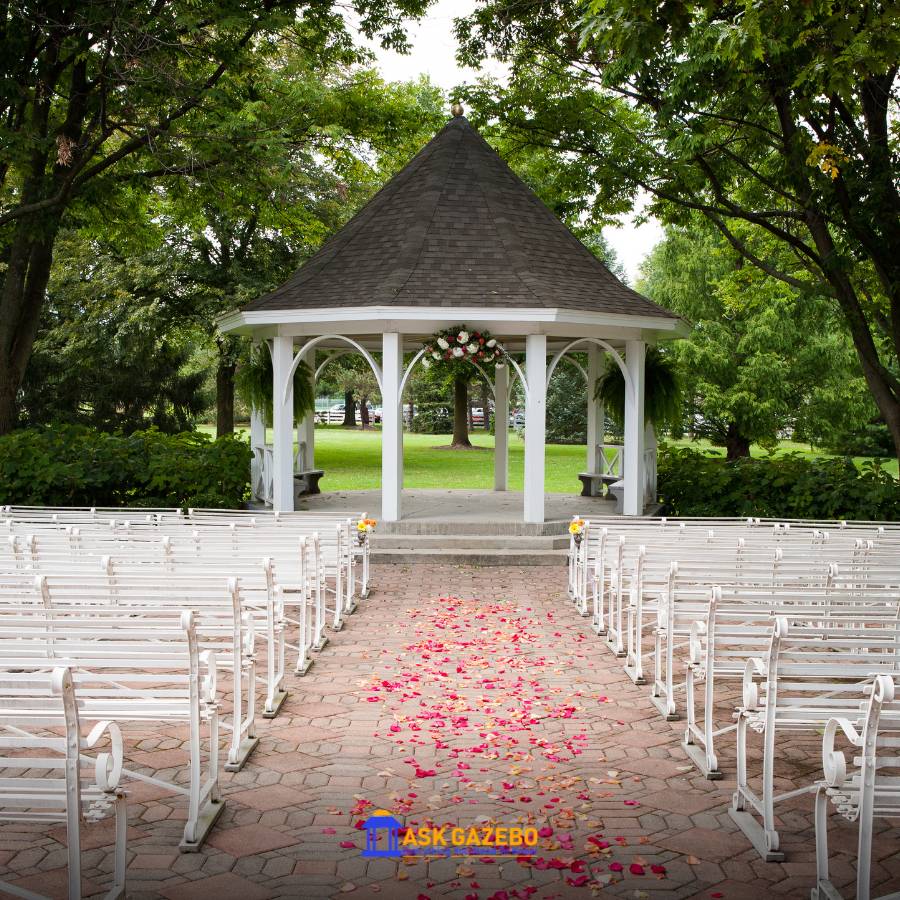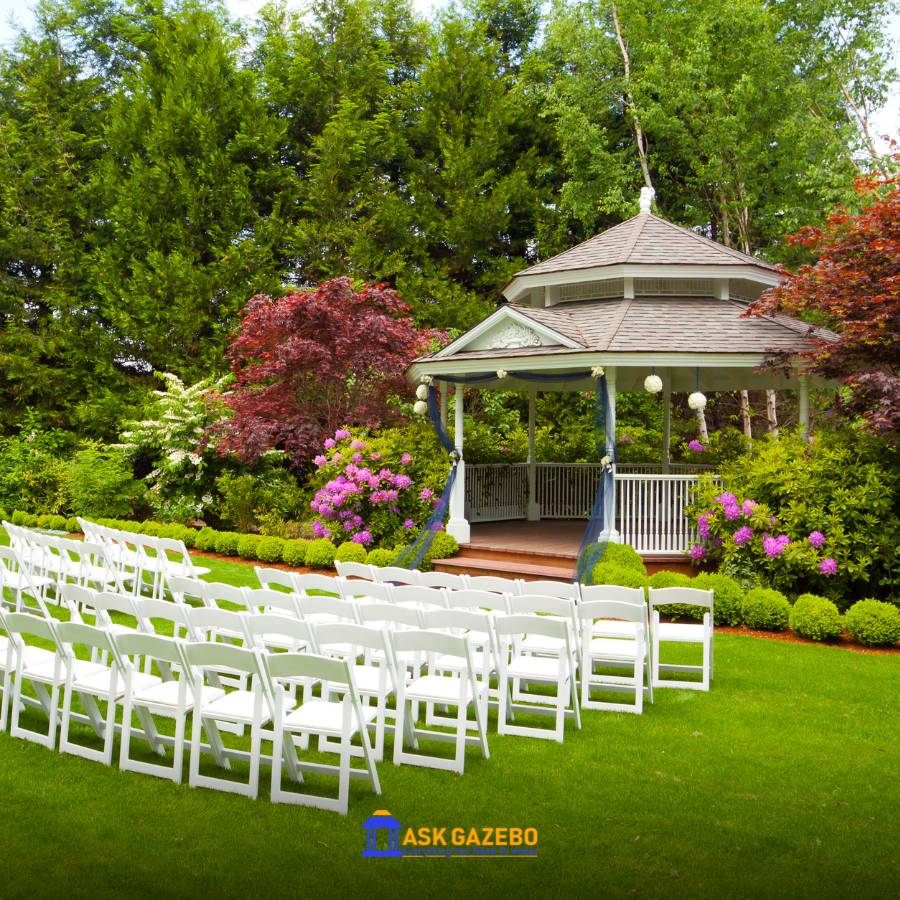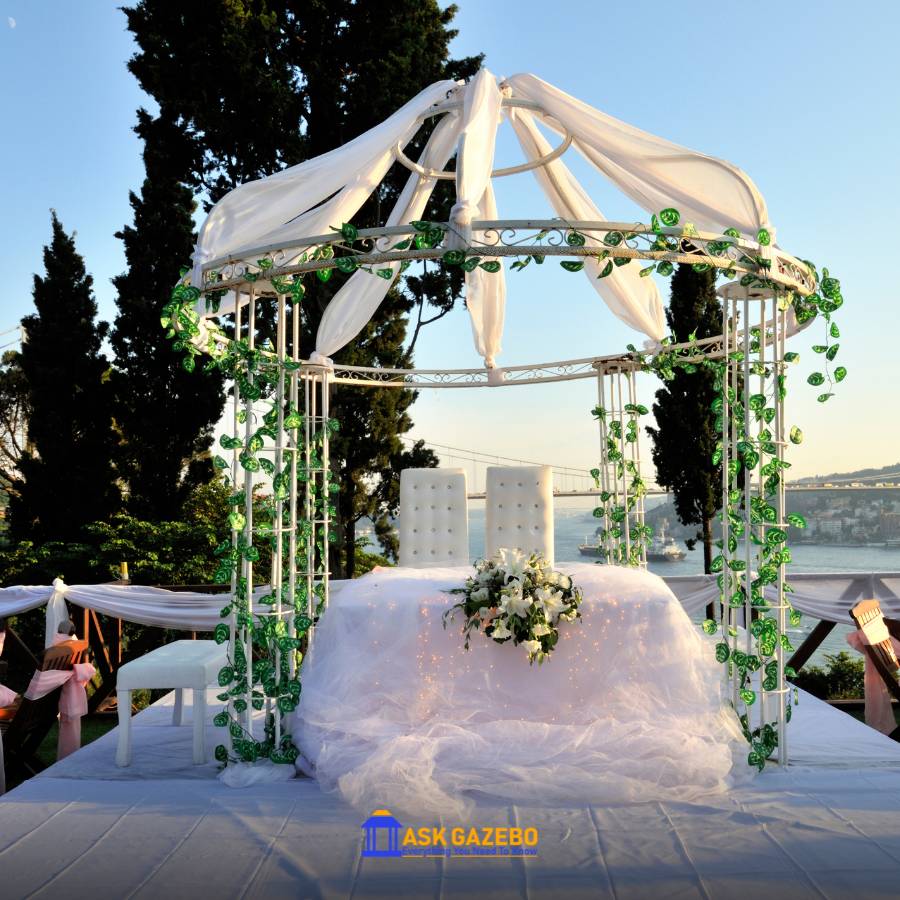So, the wedding ceremony is coming, and you want to know whether you can use your gazebo as a chuppah for your ceremony or not. And the answer is: yes, you can use your gazebo as a chuppah.
Really?
Both are standing structures, but the difference is in their use cases. A chuppah is a specific structure for a specific event. On the hand, a gazebo is a versatile structure that can be modified according to our needs, in this case, for a Jewish wedding.
So, if you want to convert your gazebo into a chuppah, stay with us.


Can a Gazebo Be a Chuppah?
Let’s be real. Not every gazebo is useable as a chuppah.
All gazebos meet all requirements of a chuppah, except the dropping cloth. So, in short, to use your gazebo as a chuppah, you need to modify it a bit according to your needs and wedding theme.
Many gazebos have similar specifications to a chuppah. So, if a gazebo meets the standard requirements of a chuppah and everyone concerned approves, it can be used as a chuppah.
A chuppah (huppah) consists of a cloth canopy supported by four poles. It creates an intimate and spiritual space, making it stand out from the rest of the wedding venue. The couple stands beneath the chuppah during the wedding ceremony while the officiant and parents stand just outside the canopy.
If you decide to use a gazebo as a chuppah, it will stay there for years and keep your wedding day memory fresh.
What Are the Requirements for a Chuppah?
The chuppah holds deep cultural and religious significance in Jewish weddings, so doing it right is important for many couples and their families.
The chuppah, or the Jewish wedding canopy, should have these essential features:
- Pillars – A traditional chuppah typically consists of four poles or pillars holding a canopy. You can choose any material strong enough to support the rest of the structure. Usually, chuppa pillars are made of birch, metal, plastic, or bamboo.
- Canopy – The canopy is often made of cloth, symbolizing the couple’s marital home together. Usually, a square piece of cloth is used as the overhead covering. Silk, cotton, wool, and velvet are popular options for the chuppah canopy.
- Open Sides – The chuppah has open sides, representing the couple’s hospitality and willingness to welcome guests into their lives. The chuppah’s poles or pillars can be decorated in any style using any material of choice as long as the sides are left open.
- Decoration – Although decoration is not a core requirement of a chuppah, it can be customized according to the wedding theme. Decorating your chuppah for the wedding will give it a personal touch and make it look amazing.
Legal and Religious Considerations
From a Jewish legal (Halakhic) perspective, a chuppah is more about the act of “home creation” rather than the structure itself (Talmud, Tractate Kiddushin). Therefore, as long as the gazebo symbolizes the creation of a new home and fulfills the symbolic aspects of hospitality, it is generally acceptable.
However, there can be significant variation in interpretation and tradition depending on the specific Jewish community, so consulting with a Rabbi is crucial.
In terms of legal considerations related to using a gazebo, it’s important to comply with all local and state laws, regulations, and ordinances. It might involve obtaining necessary permits for setting up in certain public spaces.
Laws and requirements vary widely by location, so individuals should consult local regulations to understand what might apply to them.
What Are the Differences Between a Gazebo and Chuppah?
While both gazebos and chuppahs offer unique features and visual appeal, their fundamental differences lie in their built, cultural significance, and the specific context in which they are used.
Understanding these distinctions can help couples decide which structure aligns best with their preferences, cultural background, and theme for their wedding ceremony.
Here are the key distinctions:
Purpose
A gazebo is a freestanding structure typically found in gardens or outdoor spaces. It provides a sheltered area for relaxation, festivities, or scenery enjoyment. So, a gazebo is a multi-purpose outdoor structure.
On the other hand, a chuppah is specifically used in Jewish wedding ceremonies. It symbolizes the couple’s future home and serves as a sacred space where they exchange their wedding vows.
If you value traditions, go with a Chuppah; otherwise, get a Gazebo. Remember, you can transform your gazebo into a Chuppah for weddings and other ceremonies.
Also, Learn: Does A Gazebo Increase Home Value
Cultural Significance
A gazebo is commonly used as a decorative element. Recently, it has become a popular prop providing an aesthetically pleasing backdrop for ceremonies and events.
In contrast, the chuppah holds deep cultural and religious significance in Jewish weddings. It symbolizes the couple’s future home and commitment to creating a loving and welcoming environment.
Structure
You must have seen gazebos with solid roofs and open sides, providing a beautiful outdoor living space for family enjoyment or entertaining guests. They are sturdy structures made of wood, metal, or vinyl, usually decorated with lattice, arches, or intricate designs.
On the other hand, a chuppah is a temporary structure traditionally consisting of a cloth canopy supported by four poles.
Advantages of Using Gazebo as a Chuppah
A chuppah is smaller and more fragile than a bigger and sturdier gazebo. Also, it only provides enough space for a couple. So, people can benefit more from a gazebo’s bigger size and solid build.
- Structural Stability – Gazebos are typically built with sturdy materials and construction, providing a stable and secure structure for the chuppah. When attached to a gazebo, the chuppah remains steady and intact throughout the ceremony, even when it’s windy.
- Weather Protection – A solid structure also protects from unpredictable weather. You can carry on with the wedding ceremony without worrying about rain, intense sunlight, or other weather conditions that could otherwise disrupt the ceremony.
- More Space – Gazebos often provide ample space for seating, allowing the close family to witness the wedding ceremony comfortably. It can be particularly beneficial when there is a larger number of guests.
- Customization Options – Gazebo structures are highly versatile and customizable. They can incorporate decorative elements to match the wedding theme, color scheme, or personal style. It allows for a visually stunning chuppah that is the highlight of the wedding venue.
- Aesthetic Appeal – Gazebos can add a touch of sophistication and elegance to the wedding ceremony. They serve as a beautiful backdrop for photographs and create a charming focal point during the ceremony. The gazebo’s architectural details and design can make the wedding venue more attractive.
- Versatility – When the chuppah ceremony is completed, a gazebo can be used for other purposes throughout the event. It can be transformed into a designated area for dining, dancing, or a photo booth. This versatility allows the couple to utilize the structure and create beautiful memories fully.
Transforming a Gazebo Into a Chuppah
With its roof and open sides, a gazebo provides a beautiful and practical option for a chuppah. Most of the gazebo options available these days have four posts and a roof, fulfilling the requirements for a kosher gazebo.
Using a gazebo as a chuppah doesn’t mean you can’t incorporate a tallit (prayer shawl), family quilt, patchwork, or any fabric with sentimental value into the wedding ceremony.
You can attach the desired cloth or fabric to the framework of the gazebo, creating a designated space for the couple to stand beneath. This combination incorporates the chuppah’s symbolism and a gazebo’s aesthetic appeal in one place.
Converting a gazebo into a chuppah involves a few steps:
- Ensure the gazebo fits the bill: Ensure that the gazebo is open on all sides, just like a traditional chuppah.
- Choose the cloth: Select a cloth, or tallit, to serve as the ‘roof’ of the chuppah. It is typically a white or decorated piece of fabric.
- Attach the cloth: Securely attach the chosen cloth to the top of the gazebo. Drape it over the existing roof or replace the roof entirely if possible. Ensure it’s secure so it doesn’t blow away during the ceremony.
- Decorate: Personalize the gazebo with flowers, ribbons, or other decorations to give it the desired aesthetic and make it feel more ceremonial.
- Consult a Rabbi: Consult with a Rabbi or Jewish authority to make sure that your planned setup will still meet the religious requirements of a chuppah.
Remember, a chuppah symbolizes the home that the couple will build together, so the most important aspect is that it reflects the couple and their commitment to each other.
Inspiration from Pictures








Easy Way to Build a Chuppa Yourself
Building a chuppah yourself is a great way to infuse a personalized touch into your wedding ceremony. If you have carpentry experience, this DIY project will be easier to execute.
Here’s a simple way to construct a chuppah:
Materials Needed:
- 10 Logs (8 feet long)
- Bolts and T-Nuts ( as needed)
- Fabric for the canopy (silk, satin, or lace)
- Decorative elements of choice (flowers, ribbons, or personal touches)
Step-by-step Process:
- Choose 4 similar-looking logs for the vertical posts. Consider painting or staining the poles to match your wedding theme if desired.
- Trim the logs to a similar 8 feet length.
- Build the front and rear frames first, then add the side frames. Use long bolts to secure the logs in position. (Consult the video tutorial)
- If you are building the chuppah at the location, you can dig it into the ground to keep it stable. Otherwise, secure it in heavy planters after transporting it to the final location, or use sturdy bases to keep it from rocking.
- When your chuppah frame is ready, attach the canopy. Drape the fabric over the frame top, allowing it to hang evenly on all sides. Use clips, ties, or fabric hooks to secure the canopy to the poles, ensuring it stays in place.
- Lastly, add decorative elements to personalize the chuppah. Attach flowers, ribbons, or other meaningful adornments to the canopy or around the poles.


Subscribe For More Gazebo Videos!
Ask Gazebo
FAQs
Does a Chuppah Have to Be Only Wood?
No, a chuppah does not have to be made only of wood. While wooden chuppahs are common, chuppahs can be created using various materials such as metal, PVC, bamboo, or even a combination of materials.
The choice of material depends on personal liking, cultural traditions, and the desired look to match the wedding theme.
How Big Can a Chuppa Be?
Usually, the prayer shawls used for the chuppah canopy are 5 feet 6, so it is a standard size.
However, no specific limitations exist on how big it can be. The chuppah poles must be high enough to accommodate tall people comfortably. So, 8 feet is a good height for Chuppah in most situations.
Can a Chuppah Be of Any Shape?
Yes, a chuppah can be of any shape. While the traditional chuppah design features a square or rectangular shape, many modern wedding ceremonies use different shapes.
Couples can choose a round, oval, or custom-shaped chuppah that reflects their unique style and vision for their wedding ceremony.
Can I Build a Chuppah Myself?
Building a chuppah yourself is a creative and budget-friendly option if you have the necessary skills and resources. You can easily find online tutorials, plans, and ideas to guide you through your DIY project. Ensure your chuppah is sturdy, secure, and meets standard safety requirements.
How Long Does It Take To Set up a Chuppah?
The time required to set up a chuppah can vary depending on its design complexity, size, and level of decorations. Generally, it can take a couple of hours to set up a chuppah.
The setup time shortens if you have done such a project before and are familiar with the processes involved. Also, having some help makes the setup faster and stress-free.
Conclusion
So, yes, a gazebo can easily be transformed into a remarkable chuppah, offering a blend of practicality, versatility, and aesthetic appeal. A customized gazebo is a worthwhile alternative to the traditional chuppah. With a few tweaks, couples can create a chuppah that reflects their taste and makes a perfect spot to start their journey together.









Yes, we must consult Rabbi about our plan before planning a gazebo as a Chuppah.